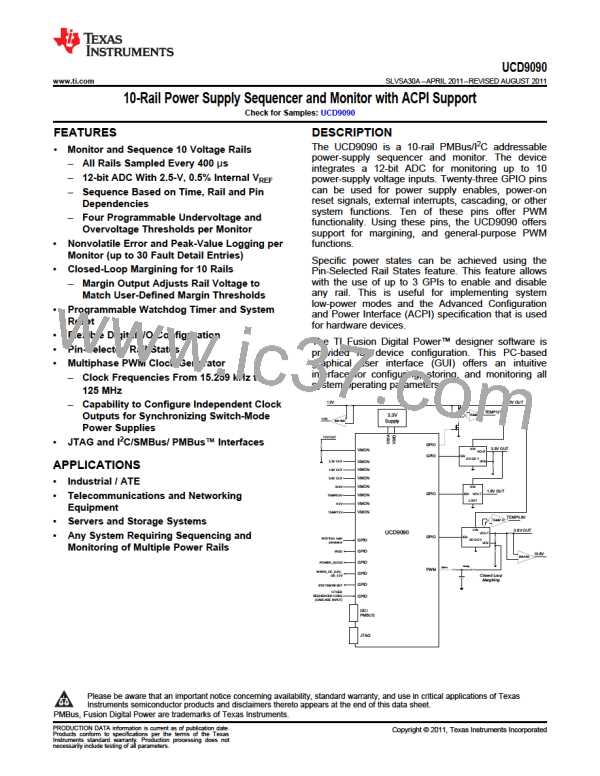UCD9090
SLVSA30A –APRIL 2011–REVISED AUGUST 2011
www.ti.com
fault-shutdown slaves sequence-off, the UCD9090 waits for a programmable delay time between 0 and 1275 ms
in increments of 5 ms and then sequences-on the faulted rail and fault-shutdown slaves according to the start-up
sequence configuration. This is repeated until the faulted rail and fault-shutdown slaves successfully achieve
regulation or for a user-selected 1, 2, 3, 4 or unlimited times. If the resequence operation is successful, the
resequence counter is reset if all of the rails that were resequenced maintain normal operation for one second.
Once shut-down-all-rails and sequence-on begin, any faults on the fault-shutdown slave rails are ignored. If there
are two or more simultaneous faults with different fault-shutdown slaves, the more conservative action is taken.
For example, if a set of rails is already on its second resequence and the device is configured to resequence
three times, and another set of rails enters the resequence state, that second set of rails is only resequenced
once. Another example – if one set of rails is waiting for all of its rails to shut down so that it can resequence,
and another set of rails enters the resequence state, the device now waits for all rails from both sets to shut
down before resequencing.
GPIOs
The UCD9090 has 21 GPIO pins that can function as either inputs or outputs. Each GPIO has configurable
output mode options including open-drain or push-pull outputs that can be actively driven to 3.3 V or ground.
There are an additional two pins that can be used as either inputs or PWM outputs but not as GPOs. Table 4
lists possible uses for the GPIO pins and the maximum number of each type for each use. GPIO pins can be
dependents in sequencing and alarm processing. They can also be used for system-level functions such as
external interrupts, power-goods, resets, or for the cascading of multiple devices. GPOs can be sequenced up or
down by configuring a rail without a MON pin but with a GPIO set as an enable.
22
Copyright © 2011, Texas Instruments Incorporated

 TI [ TEXAS INSTRUMENTS ]
TI [ TEXAS INSTRUMENTS ]